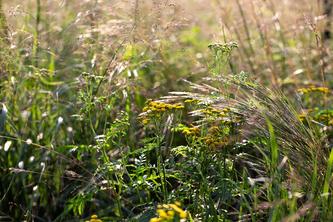
World Migratory Bird Day is celebrated annually on the second Saturday in May and October to raise awareness of migratory birds and their habitats. This year’s first observance is May 14.
Alexis Grinde with the Natural Resources Research Institute (NRRI) at the University of Minnesota Duluth answers questions about migratory bird populations in Minnesota, their migration routes and patterns and the condition of their habitats.
Q. What species of migratory birds are commonly found in Minnesota and where?
Grinde: Minnesota contains multiple habitat types—from grassland habitats to boreal forests. These diverse habitats attract different suites of migratory birds in the spring and fall. The intersection of these habitats in a single state means that Minnesota is an extremely biodiverse state during migration and the summer breeding season!
Hundreds of species of birds migrate to and through Minnesota each year. One of the first signs of spring is huge flocks of geese and waterfowl arriving as soon as open water is available. Eagles and hawks start to arrive back in large numbers around March; followed by the arrival of the short-distance migrants such as the American Robin, Red-winged Blackbird and Eastern Bluebird that spent the winter in the southern United States. After the weather warms and leaves start to appear on trees, long-distance migrants—species that have spent the winter in Central or South America—including orioles, tanagers and warblers begin to arrive and prepare for the breeding season.
Q. What is the typical migration route for these migratory birds?
Grinde: Migration routes vary, depending on the species and where they spent the winter. However, a few generalizations can be made. In the spring, most birds move straight north, arrive at their breeding grounds and establish the best territories as quickly as possible. In the fall, birds will generally take a more southeasterly route at a leisurely pace to get to their wintering grounds.
The majority of bird species migrate at night and use multiple cues to help them navigate in darkness, including magnetic and polarized light fields and the stars. During a typical night migration, an individual bird likely tries to travel as far as it can, given its energy stores and flying conditions. Some species, such as Tundra Swans and Sandhill Cranes, are dependent on very specific habitats during migration and will follow traditional migratory routes and stop at the exact same areas each year. Because these species migrate in groups—often including adults and their offspring— knowledge of these prime stopover areas is passed down to future generations.
Q. How and what changes in habitats impact migratory birds and their migratory behavior?
Grinde: Of the approximately 315 species that are regularly detected in Minnesota, nearly 250 breed in the state. Quality habitat that provides food and shelter is critical for birds during migration and for breeding activities. In terms of migration, the majority of birds are relatively flexible and use any available stopover habitat that they can find. Some bird species stop for a day (or even a few hours) during which time they try to regain fat stores used to migrate by eating as much as possible. Other birds stay for much longer to refuel or wait for nice weather before making another migratory flight. For these species, habitat quantity and quality are the most pressing concerns. If a bird is unable to find enough suitable stopover habitat, it will be unable to refuel and make another migratory leap. Because human presence on the landscape in much of the state is high, we must make sure that as much natural habitat is saved as possible. Additionally, if a bird stops over at a site of lower quality (e.g., the site is filled with invasive plant species), it may take much longer to gain enough nutrients to prepare for the next leg of the journey. Ensuring high quality stopover and breeding habitat is available for all birds is a top priority for bird conservation!
Q. How is the current highly pathogenic avian influenza (HPAI) outbreak impacting migratory birds?
Grinde: Avian influenza (bird flu) is a disease caused by a virus that can infect the respiratory and gastrointestinal tract of birds. Wild birds including gulls, terns and waterfowl such as ducks, geese and swans are thought to be natural hosts for bird flu viruses. In previous bird flu outbreaks, it seemed that most wild birds infected with the flu virus were asymptomatic and the major impact and mortality was associated with domestic poultry. However, the current strain of avian influenza HPAI A(H5) is considered highly pathogenic and, as of early April, more than 40 wild bird species in more than 30 states have tested positive. In fact, this strain has been detected in a wide variety of species including owls, eagles and pelicans. As more birds return to that state during spring migration, there is an increased likelihood that the virus will infect more birds and more species. We don’t have enough information about infection rates or mortality at this point, and it is a cause for concern. Historically, bird flu was considered a poultry disease. However, increasing evidence suggests this emerging disease is a threat to wild birds as well.
Q. What are you doing to advance research on Minnesota’s migratory birds?
Grinde: The Avian Ecology Lab at the Natural Resources Research Institute is on the cutting edge of the study of migratory bird species in Minnesota. We specialize in using the latest technology to answer questions about how, where, when and why birds migrate. For example, along with collaborators across North America, we have placed geolocators and GPS tags on Common Terns in order to understand migration routes and where they spend the winter.
Our group is also heavily involved in a global effort called the Motus Wildlife Tracking System. The goal of this project is to use automated telemetry to track the migratory movements of birds that are too small to be equipped with more sophisticated GPS tracking devices. Our group currently has nine stations along the north and south shore of Lake Superior. These stations have detected birds that were tagged as far away as Maryland and British Columbia! These new technologies have helped us to start to unravel the mysteries of migration and help inform conservation of Minnesota's birds.
Alexis Grinde, Ph.D., is a wildlife ecologist and research manager of the Avian Ecology Lab at the Natural Resources Research Institute. Her research focuses on conservation ecology including studying the large-scale impacts of environmental change on wildlife, biodiversity and ecosystem function. The Avian Ecology Lab focuses on developing economically sustainable conservation strategies and land management guidelines to preserve and enhance the species diversity of Minnesota bird populations and to protect species in need of greatest conservation.
-30-
About “Talking...with U of M”
“Talking...with U of M” is a resource whereby University of Minnesota faculty answer questions on current and other topics of general interest. Feel free to republish this content. If you would like to schedule an interview with the faculty member or have topics you’d like the University of Minnesota to explore for future “Talking...with U of M,” please contact University Public Relations at [email protected].
About the Natural Resources Research Institute
As part of the University of Minnesota system research enterprise, the Natural Resources Research Institute at the University of Minnesota Duluth employs over 140 scientists, engineers, technicians, staff, and students in two industrial research facilities. Through collaborative partnerships, NRRI delivers the innovative tools and solutions needed to utilize and sustain Minnesota’s valuable natural resources.
- Categories:
- Agriculture and Environment
- Animals





